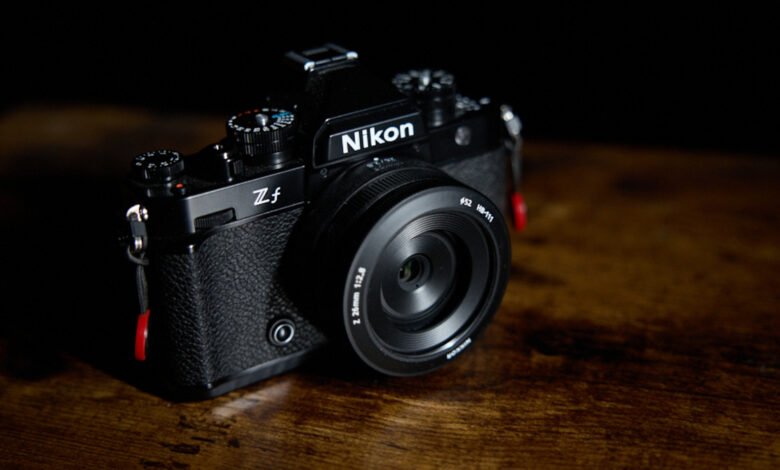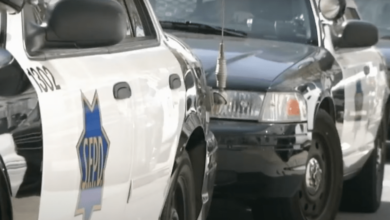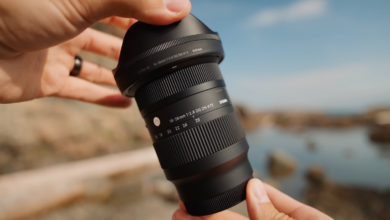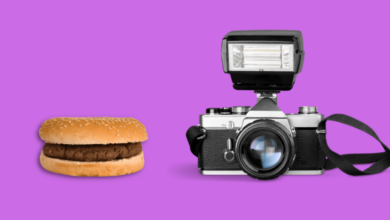The Nikon ZF Is One of the Most Versatile Cameras on the Market Today

Looking for a camera that can serve many purposes, but not sure where to look? The Nikon Z f might be the right place to start.
As I’ve said many times before, there is no such thing as a perfect camera. Only the perfect camera for your specific tasks. Some tasks call for beaucoup megapixels. Some tasks call for a high frame rate. Some tasks call for 8K. Some call for a camera that can fit into a coat pocket. Very rarely will you find these things embodied in the same camera. And, the closer a camera gets to achieving multiple metrics on that list, the higher the price tag goes.
I am a professional photographer and director working on large scale ad campaigns for various brands and companies. My professional camera of choice for stills is the Nikon Z9. I’ve shot with every brand on the market, so my choice isn’t a confirmation of superiority. It simply means that, for my own particular preferences and client needs, the Z9 is the ultimate combination of speed, megapixels, video spec, ergonomics, and performance. It took me years to finally find a camera that was so well suited to my needs. And, now that I’ve found it, I’m not looking back.
With that said, as I mentioned in my article a few weeks ago about reasons one might want to have a “personal” camera in addition to their professional one, the Z9 comes with the caveat that its size makes it somewhat prohibitive for me to use it in certain situations. Flatly stated, it’s too big and too nice for me to personally feel comfortable doing things like street photography or many travel applications where smaller and more discrete is the order of the day.

That is why I was so excited when Nikon recently released the Z f. While its 24.5 MP sensor might not match the 45.7 MP of my Z9, its small form factor more than makes up for that by allowing it to be used in certain situations where its big brother might not. As I’ve finally gotten an extended time to use the Z f over the last month or so, it’s become clear that, aside from just being small, there are several things about the Z f that make it perhaps the most versatile camera on the market at the moment.
Here’s what I mean.

Size Matters
Since we’ve already brought it up, let’s get the size out of the way first. While the camera isn’t exactly pocketable in jeans, it is small enough to slip into the pocket of a larger coat. More importantly, even when hanging around my neck, it doesn’t draw the same level of attention as something like a full sized DSLR or mirrorless camera. I am a larger man very used to drawing attention most places I go. There are many reasons for that which I won’t go into here. But the end result is that existing in the world incognito can be difficult. If I add to this a large camera and lens and start pointing it at strangers, well, let’s just say that it doesn’t make for a relaxing afternoon. So, carrying a small camera that nobody really notices is a major plus when shooting just for fun. Just like carrying my Z9 on a professional set is actually a plus because it, rightly or wrongly, implies a certain level of professionalism to my models which can affect their performance, carrying a smaller Z f on the streets allows strangers to be at ease. To be natural. And, afterall, that’s exactly what I want when capturing street images in the first place.

The size also makes it a great deal easier to pack up and travel with when going on trips. Sure, you sacrifice megapixels, but, to me, that’s worth the trade off if it will allow me to get into different locations and places that I might not have access to when carrying a larger camera. Either because of the size or because, again, the professional looking camera may spook some security guards who have been advised not to allow in any professional photographers.

24.5 MP Is More Than Enough For Most Applications
There are no doubt many professional needs for more megapixels. And, professional needs or not, I am not exactly unfamiliar with being a sucker for megapixels myself. We all love an image that we can get home to the computer and zoom in, and in, and in, while still resolving detail. We all like the freedom to be able to crop judiciously without major penalty. And, if you are shooting for clients that are going to make large commercial prints or need to zoom in with impunity to bring out certain details, megapixels do matter.

But, for the majority of photographic applications, 25 MP is more than enough. For editorial stories, headshots, weddings, documentary and most personal photography. 25 MP is almost always going to be sufficient. Certainly for anything that is only going to be shown digitally or on social media, the race for more megapixels really isn’t offering you a great return on investment.

For the Z f in particular, I feel as though its strong suit is in some of the areas I mentioned in the previous paragraph. There are plenty of cameras on the market, including my aforementioned Z9, with more megapixels for bigger commercial jobs. The Z f is a camera I would want to use for everything else. In the time I’ve had it so far, I’ve done walkabout photography, travel photography, as well as some light portraiture. And, at no point, did I find myself wishing I had more megapixels to work with. If anything, I appreciated the smaller file size not clogging up my computer.

Style
Let’s face it, the Nikon Z f is just pretty. Maybe it’s because I’m old enough to remember when its “retro” style was just, well, the normal style that most cameras looked. But just as I feel as though I feel as though cars of today, despite the amazing technology, lack much of the visceral style of cars of the part, I feel as though most modern mirrorless cameras are loaded with technology but are lacking on aesthetics. Just a personal opinion.
But a camera like the Z f has a style about it that makes me want to carry it with me. It improves my outfit rather than making me feel like a professional nerd for carrying it in a social setting. The only comments I’ve gotten carrying the camera around my neck have been purely sartorial. I know, I know, the way a camera looks shouldn’t matter. But, the simple fact is that the camera’s physical appearance means that I feel comfortable carrying it in more situations. Carrying it in more situations gives me the opportunity to take more pictures. This, in turn, means that I’m getting more value out of my purchase. So, yes, looks can matter.

The Black and White Switch
While we are on the topic of things that I seem to be enjoying more than I expected, the control dial on the top right of the camera that allows you to quickly switch into black and white mode has gotten far more use than I would have imagined. I don’t have to use it. I’m likely going to want to handle my black and white conversions in post anyway. But let’s just say that I don’t exactly hate that the option is there.
Especially since Nikon has given us three separate black and white modes. I’m partial to the Deep Tone Monochrome, myself. And because of the way in which I use this camera, mostly for street photography, visualizing my scene in black and white with the flip of a switch has proven incredibly useful. Unless I shoot JPGs (or JPGs + raw) the look goes away when I bring them into Capture One. But, the preview itself helps me see what I’m aiming for as an end result. Or, if I want to pull the black and white images straight out of camera as JPGs, I’ve already got a truly pleasing result.
True, I can do all of this without the dedicated switch. And, true, I probably wouldn’t use it for my professional work where I’m going to want more control in post. But, hey, for a camera built around the concept of fun, this is pretty darn fun.

Ergonomics
It simply must be acknowledged that with that retro style does come a couple drawbacks. In many early reviews of the Z f, I’ve heard some fair complaints about the camera’s ergonomics. Mostly related to the camera’s lack of a deep grip which we have become accustomed to with modern cameras.
I don’t disagree with the desire for a deeper grip, which I will address in a second. But, it’s also somewhat of a funny complaint if you stop to think about it. The camera’s main selling point is that it is a retro camera and thus has retro styling. Many of the cameras I used back in the day didn’t have the deeper grips that we have on cameras today. Those deeper grips were the result of years of product development and camera manufacturers learning that customers liked deeper grips as they made the cameras easier to hold. Deeper grips were a positive development in cameras over time. And, as someone with larger hands, nobody loves a deep grip more than me. In fact, it’s one of the main reasons why I love my Z9 so much, despite its large form factor. I love how its large body settles into my hand.

But, again, the Z f is designed to be a retro body. And, as a retro body, it’s only logical for it not to have a modern deeper grip. It is a consideration you’ll need to think about when deciding whether or not the Z f is right for you. But the design is not out of character.
SmallRig has helped with this a bit by manufacturing an attachment that helps bolster grip of the Z f grip without majorly compromising the camera’s aesthetics. To me, purchasing this grip is a no brainer if you plan to buy the Nikon Z f. Even if you don’t use it most of the time, if you were ever to want to use the Z f with larger lenses, having the option of the additional grip could be key. Although, I should also point out that, with my larger hands, I did find myself wanting an even larger grip than the SmallRig system. Perhaps they will release a second version. I found that my hands were still too large and that, when shooting, even the grip accessory wasn’t big enough to make a substantial difference. So, even though the grip was the first accessory on my list, I often end up just shooting with the camera sans grip for most of the time. But, despite that, I still think the grip accessory is a worthwhile add on as it can come in handy in a number of situations.

Lens Choice
When it comes to traveling small with a camera, truth be told, it’s usually the lens that’s the problem rather than the camera body itself. If you are used to shooting with more professional lenses like the holy trinity (14-24mm, 24-70mm, 70-200mm f/2.8), then you know that those lenses are almost never “small.” Some of them have gotten smaller in the Nikon Z system, but they are still not exactly tiny. The same is true for equivalent lenses from every brand. If we consider the retro ergonomics mentioned in the last section, choosing your lens for the Z f becomes more of a consideration.

When shooting with the Z f, I’ve tended to stick to the 26mm pancake lens and the 28mm and 40mm muffin primes. That has kept the package light and compact and is a perfect fit to the camera’s ergonomic design. If I do need a zoom, I’ll opt for the 24-70mm f/4 rather than the f/2.8 just to, again, save on weight and improve the relative balance with the smaller body. Note that it is not impossible to mount even Nikon’s longest lens to the Z f. All the lenses that work on my Z9 work on the Z f which only makes it more versatile. But, the Z f is the kind of camera that seems custom made for a smaller footprint. So, even though I give up some of the flexibility I would get with a longer zoom, I tend to focus my use of the Z f on small portable lenses and a lower profile.


So, What Makes It So Versatile?
Even with the ergonomic and lens preferences I mentioned above, I still find the Nikon Z f to be one of the most versatile, and thus most valuable, cameras on the market today. Why? Simply because, aside from high megapixel scenarios, there are virtually no scenarios where this camera wouldn’t be a solid fit.
Aside from the Z8 and Z9, the Z f currently has the best video specs of any Nikon mirrorless camera. It may not shoot NRAW video, but pretty much everything else is there. This includes in-body N-log 10-bit profiles. It also has the improved autofocus system of the two big brothers. Better than the Z 6II and Z 7II. I find it highly likely that, when the Z 6III and Z 7III are released, they too will have the new autofocus system that benefits from the EXPEED 7 sensor in the Z f, Z8, and Z9. But, for now, given the better sensor, better autofocus speed, and better video options, the Z f is firmly the third best camera in the Nikon mirrorless system.

That means that, if you are shooting with Nikon and don’t need the high megapixels and/or can’t afford the higher purchase price of the Z8 or Z9, the Z f is objectively the best professional option Nikon offers at the moment.
Add to that the style of the camera which makes it one of the most aesthetically pleasing cameras on the market. That means that, for non-professional applications, you are more likely to carry the Z f with you than any other camera. Looks may not equate to a tech spec. But, if they get you more opportunities to use the camera, you are getting more value for your investment.
Also, while $1,996.95 is not exactly nothing, it’s a very fair price, relative to the market, for a full frame camera with these capabilities. I would have no hesitation using the Z f as the third camera on set (behind my two Z9s) in a professional scenario. And, I would have no hesitation using it in a non-professional setting when just out shooting for fun. The $2,000 mark seems to be a sweet spot for 25-ish megapixel full frame cameras, making it also a sweet spot for emerging photographers, who may not have the budget or clients yet to make sense of a $4,000 camera, but still want something full frame that can be used for professional use. The Z f sits right in that spot while coming in a stylish and usable package.

As mentioned earlier, you’ll know right away if the ergonomics are for you. When it was first announced, I struggled to think of what the key differentiating factor would be between the Z f and a potential Z 6III when it is eventually released. They have similar megapixels and a similar price point. Why would one choose one versus the other? I haven’t seen a potential new Z 6III yet. So I have no idea what specs that camera would possess. But, on a basic level, it seems as though one of the main separators would be that those who need the deeper grip and are likely to use the camera more for business than pleasure, may opt for the larger Z6III. Think event or wedding photographers who are going to have the camera in hand non stop all day. While those who want the same specs, but are going to use the camera primarily for pleasure might opt for the Z f. Again, that’s completely a guess since I know nothing about what the Z6III will be. But, the fact that I even have to ask that question suggests just how useful the Z f can be. Both for personal and professional use.

Conclusion
It’s funny because, as I wrap up this article, I’m realizing that I’ve gone this long and haven’t even mentioned the most obvious part of the Z f: the dials. Part of the retro design, the tactile dials atop the camera are a throwback to the analog days when quick command dials were still a thing of the future.
Some may like the dials as they give them a sense of nostalgia. Some may like the dials as they force them to slow down and really consider the image. Oddly enough, I like that I have the choice to either use the dials or not use them. Because I flip frequently between stills and video (with a very specific shutter speed desired), I actually spend most of my time with the camera in command dial mode. In other words, I don’t do much with the dials atop the camera other than look at them for style. I change exposure with the normal command dials the same way I would on any model mirrorless camera. But, the design of the dials is still far from a waste of time because it gives me the option.

Likewise, I am not a vlogger. So, while I appreciate the fully articulating screen for the occasional selfie, my opinion on whether or not a screen should fully articulate or not is neither here nor there. Oddly again, my favorite part of the fully articulating screen is that I can flip it all the way closed against the back of the camera. Completely out of view. This might seem counterintuitive, but getting rid of the rear LCD altogether gives me great pleasure while shooting. Not only is the styling of the camera retro, so is the performance. It brings me back to the basics of photography. Chasing the light. Composing to enhance the story. Not focusing on the tech. Focus on the image.
Pros
- Small form factor
- Pro video specs including internal N-log
- Styling
- Black and white switch
- Image quality
- Dials
- Fully articulating screen
- Dual card slots
- EXPEED 7 processor
- Autofocus
- Focus point based IBIS system
Cons
- Shallow grip
- Wish it had the sensor shield of the Z8/Z9

I think the Z f could be a good fit for many types of photographers. It’s a great fit for an emerging photographer or a professional photographer, especially in the editorial, documentary, or event space, whose work doesn’t demand a high megapixel count. It’s a good camera for analog photographers looking for a familiar experience in the digital world. It’s a good camera for a pro Nikon shooter looking for an additional body for personal photography that can also double as a pro camera in a pinch. It’s a good camera for a travel photographer who needs to lighten their load. It’s a good camera for a hobbyist or advanced amateur who is shooting purely for the love of the game.
Technically speaking, the Z f is well suited for almost every photographic scenario. Only you can decide whether or not the form factor suits your unique approach. But, without question, the Z f is one of the most versatile cameras on the market today. A camera that is both fun and functional. The only limit is your creativity.




